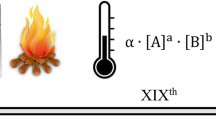Abstract
An illustration of the distinction between these two types of chemical bonds is proposed, which is based on the properties of the molecule once built. Bond energies, overlap populations and group charges vary considerably from one compound to the other; more, a recent criterion given by two of the authors seems to be particularly suitable for describing the character of the bond. Lastly, one tries to give an explicit signification to the usual chemical symbols.
Résumé
On propose un exemple quantitatif de la distinction entre une liaison de covalence et une liaison de coordination; cette différenciation, fondée sur les propriétés de la molécule une fois formée, semble très nette pour les énergies de liaison, les populations de recouvrement et les charges des groupes; en particulier, un critère récent, proposé par deux des auteurs, est remarquablement vérifié. Enfin, on essaie de préciser la signification des symboles chimiques traditionnels.
Zusammenfassung
Es wird ein quantitatives Beispiel der Unterscheidung zwischen einer kovalenten und einer koordinativen Bindung angegeben, die auf den Eigenschaften des vorliegenden Moleküls beruht. Sie erscheint sehr günstig für die Bindungsenergien, die Überlagerungspopulationen und die Gruppenladungen. Insbesondere wird ein Kriterium, das kürzlich von zwei der Autoren angegeben wurde, gut verifiziert. Schließlich wird versucht, die üblichen chemischen Symbole zu präzisieren.
Similar content being viewed by others
Bibliographie
Heitler,W., London,F.: Z. Physik 44, 445 (1927).
Hund,F.: Z. Physik 40, 742 (1927), 42, 93 (1927).
Hurley,A.C., Lenhard-Jones,J., Pople,F.R.S., Pople,J.A.: Proc. Roy. Soc. (London) A 220, 446 (1953)
Parks,J.M., Parr,R.G.: J. chem. Physics 28 (2), 335 (1958)
Bratos,S., Durand,P.: J. chem. Physics 43 (8), 2670 (1965)
Durand,Ph., Daudel,R.: Cahiers Ph. 166–167, 225 (1964).
Daudel,R.: C. R. Acad. Sci., France, 237, 601 (1953)
Daudel,R.: Les fondements de la chimie théorique, Paris: Gauthier-Villars (1956)
Odiot,S.: Thèse, Paris (1958).
Berthier,G.: Colloque International du C.N.R.S. n∘ 195, Menton, 8/13 juillet, 1970.
Boys,S.F.: Rev. mod. Physics 32, 296 (1960); - Quantum Theory of atoms molecules and the solid stated., P.O.Löwdin, p. 253. New York: Academic Press 1966.
Kuznesof,P.M., Shriver,D.F., Stafford,F.E.: J. Amer. chem. Soc. 10, 2557 (1968).
Veillard.A., Daudel,R.: Colloque International du C.N.R.S. n∘ 191, Paris 27/31 octobre 1969, p. 23, Ed. du C.N.R.S. (1970); - ibidem p. 15.
Veillard,A.: IBMØL Version IV, Special IBM Technical Report, San José (1968).
Clementi,E.: Physic. Rev. 133 (2A), 419 (1963).
Csizmadia,I.G., Harrison,M. C., Sutcliffe,B. T.: Theoret, chim. Acta (Berl.) 6, 217 (1966).
McKelvie,N.: Chem. Engng. News 42, 47 (1964).
Mulliken,R.S.: J. chem. Physics 23 (10), 1833, 1841 (1955).
Millie,Ph., Berthier,G.: Colloque International du C.N.R.S. n∘ 191, Paris 27/31 octobre 1969, p. 31 Ed. du C.N.R.S., Paris (1970).
Veillard,A., Levy,B., Daudel,R., Gallais,F.: Theoret, chim. Acta (Berl.) 8, 312 (1967).
Armstrong,D.R., Duke,B.J., Perkins,P.G.: J. chem. Soc. (London) 1966, 2566.
Demuynck, J., Veillard,A.: Chem. Comm. 1970, 873.
Serafini,A., Labarre,J.F., Veillard,A., Vinot,G.: à paraître.
Lewis,G.N.: J. Amer. chem. Soc. 33, 762 (1916).
Sidgwick,N.V.: The Electron Theory of Valency, Oxford, Univ. Pr. 1927.
Lowry,T.M.: Trans. Faraday Soc. 18, 825 (1923); J. chem. Soc. (London) 1923, 822.
Salez,C., Veillard,A.: Theoret, chim. Acta (Berl.) 11, 441 (1968).
Author information
Authors and Affiliations
Additional information
Les auteurs tiennent à remercier très vivement M. M. Berthier et Millié d'avoir mis à leur disposition le programme de localisation indispensable à ce travail, ainsi que Mademoiselle Le Guen et le C.I.R.C.E. pour la réalisation des calculs sur l'ordinateur IBM 360-75.
Rights and permissions
About this article
Cite this article
Aslangul, C., Veillard, A., Daudel, R. et al. Etude quantitative de la distinction entre une liaison de covalence et une liaison de coordination: les molecules de borazane et d'aminoborane. Theoret. Chim. Acta 23, 211–225 (1971). https://doi.org/10.1007/BF00530232
Received:
Issue Date:
DOI: https://doi.org/10.1007/BF00530232




